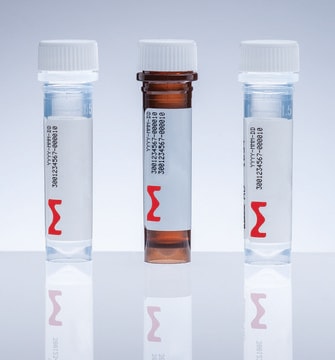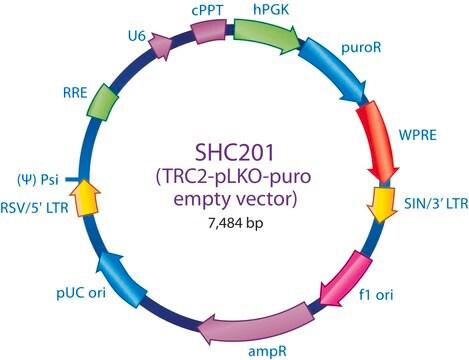SH1911
MISSION® shRNA Human Gene Family Set, Bacterial Glycerol Stock
Apoptosis Pathway
Iniciar sesiónpara Ver la Fijación de precios por contrato y de la organización
About This Item
Código UNSPSC:
41106609
NACRES:
NA.51
Productos recomendados
Línea del producto
MISSION®
temp. de almacenamiento
−70°C
Información sobre el gen
¿Está buscando productos similares? Visita Guía de comparación de productos
Categorías relacionadas
Descripción general
The clones are sequenced-verified shRNA lentiviral plasmids (pLKO.1-puro) provided as 50 μl bacterial glycerol stocks (Terrific Broth, carbenicillin at 100 μg/ml and 15% glycerol). The set comes in 96-well plates that are barcoded for simple identification. A CD containing RefSeq, gene description, gene symbol, clone ID, hairpin sequence, locus link, and plate map positions are provided with the gene family set.
Otras notas
Each MISSION shRNA clone is constructed within the lentivirus plasmid vector, pLKO.1-Puro, followed by transformation into Escherichia coli. The pLKO.1-Puro vector contains bacterial (ampicillin) and mammalian (puromycin) antibiotic resistance genes for selection of inserts in either bacterial or mammalian cell lines. Each clone set consists of an average of 3-5 constructs that have been designed against each target gene using a proprietary algorithm. Therefore, a range of knockdown efficiency, with at least one construct from each gene set being >70%, can be expected when using these clones. This allows one to examine the effect of loss of gene function over a large series of gene knockdown efficiencies. Each shRNA construct has been cloned and sequence verified to ensure a match to the target gene.
For a detailed listing of other available gene family sets, visit the gene family set website.
Number of Genes: 443, Number of Clones: 3512
The exact gene and clone count at time of purchase may vary slightly as the TRC library is continually updated.
Información legal
Use of this product is subject to one or more license agreements. For details, please see http://sigmaaldrich.com/missionlicense .
MISSION is a registered trademark of Merck KGaA, Darmstadt, Germany
Código de clase de almacenamiento
10 - Combustible liquids
Clase de riesgo para el agua (WGK)
WGK 3
Punto de inflamabilidad (°F)
Not applicable
Punto de inflamabilidad (°C)
Not applicable
Certificados de análisis (COA)
Busque Certificados de análisis (COA) introduciendo el número de lote del producto. Los números de lote se encuentran en la etiqueta del producto después de las palabras «Lot» o «Batch»
¿Ya tiene este producto?
Encuentre la documentación para los productos que ha comprado recientemente en la Biblioteca de documentos.
Role of apoptosis in the pathogenesis of COPD and pulmonary emphysema
Demedts, I. K., et al.
Respiratory Medicine, 7, 53-53 (2006)
M A Miller et al.
Apoptosis : an international journal on programmed cell death, 11(1), 15-24 (2005-12-24)
Caspase 8 is a key apoptotic factor in the receptor/ligand apoptosis-signaling cascade. Absent caspase 8 expression is shown to correlate with poor prognosis in neuroblastoma. Paradoxically, the caspase 8 gene can produce as plice variant and novel inhibitor of itself-caspase
Apoptosis, pyroptosis, and necrosis: mechanistic description of dead and dying eukaryotic cells.
Susan L Fink et al.
Infection and immunity, 73(4), 1907-1916 (2005-03-24)
Susan E Logue et al.
Biochemical Society transactions, 36(Pt 1), 1-9 (2008-01-23)
Apoptosis, a highly controlled mode of cell death, is utilized to eliminate superfluous, aged, injured or infected cells from the body. Caspases, a family of aspartic acid-specific proteases, are the major effectors of apoptosis. To curtail their activity, caspases are
Dmitri V Krysko et al.
Methods (San Diego, Calif.), 44(3), 205-221 (2008-03-04)
Three major morphologies of cell death have been described: apoptosis (type I), cell death associated with autophagy (type II) and necrosis (type III). Apoptosis and cell death associated with autophagy can be distinguished by certain biochemical events. However, necrosis is
Nuestro equipo de científicos tiene experiencia en todas las áreas de investigación: Ciencias de la vida, Ciencia de los materiales, Síntesis química, Cromatografía, Analítica y muchas otras.
Póngase en contacto con el Servicio técnico







